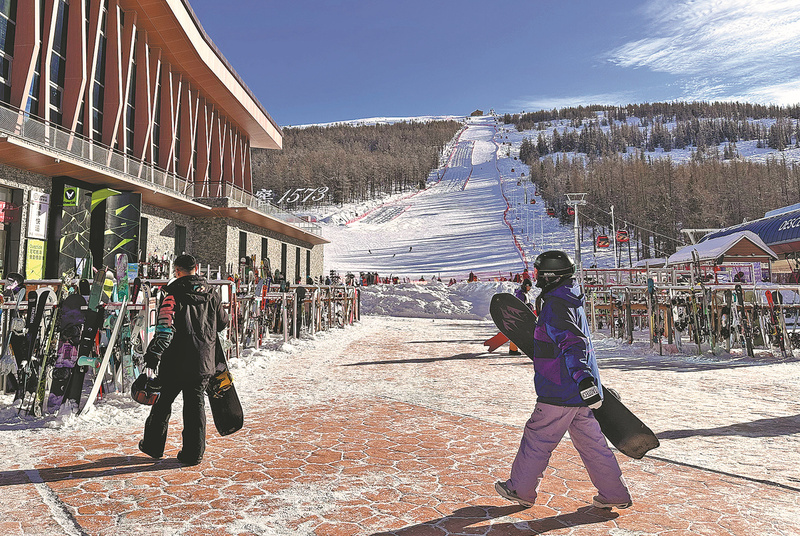
The best season for skiing has arrived.
Sun Muyao saved up his annual leave to visit the Koktokay International Ski Resort in Altay, Xinjiang Uygur autonomous region, last month. His plan for the end of the year was to become a fully certified ski instructor.
Despite traveling alone from Jilin city, over 4,000 kilometers away in Northeast China, he quickly made new friends who had the same passion, including Yu Momo from Yinchuan in the Ningxia Hui autonomous region.
An experienced skier, Yu has visited more than 20 ski resorts in different countries and eventually chose to open a guesthouse in Koktokay where he stays for about six months a year.
Winter sports in Xinjiang attract large numbers of tourists from all over the country. According to the local cultural and tourism bureau, during the just-concluded New Year's holiday, ski resorts in Xinjiang received over 100,000 visitors, with Koktokay International Ski Resort receiving 7,600, over four times the number last year, which was affected by COVID-19.
Comparing holiday data released by various provincial cultural and tourism bureaus, Xinjiang is leading in terms of the pace of recovery of its tourism market. During the three-day New Year's holiday, Xinjiang received more than 1.66 million tourists, a year-on-year increase of 195 percent, and earned tourism revenue of 1.76 billion yuan ($246 million), a year-on-year increase of 424 percent.
According to the autonomous region's department of culture and tourism, there are 188 ice and snow venues in the region, including 101 ski resorts and six five-star ones such as Koktokay International Ski Resort.
"Koktokay should be the dream of every skier. It is the ceiling of domestic ski resorts," Sun said. "There are many ski slopes here, with challenging slopes and beautiful scenery, and most importantly excellent snow conditions."
Li Xiangbao, a staff member at the ski resort, said that Koktokay is located at a golden latitude for skiing, with a snow season lasting up to 240 days from the National Day holiday in October and ending in early June.
"It combines advantages such as a long snow period, abundant snowfall, good snow quality, multiple ski slopes, large vertical drops, low wind and a great sensory experience, which is why it is highly favored by experienced skiers," he said.
He added that the Koktokay ski resort is relatively young. "It officially opened in 2020 and has built 27 ski slopes. The highest altitude is 3,100 meters, with a maximum vertical drop of 1,350 meters, including one of the steepest black diamond slopes in the country."
Li said that the resort can accommodate 6,000 visitors per day, and the number of visitors has exceeded 1 million since it opened.

"When tourists come here to ski, it directly promotes the employment of local farmers and herdsmen. According to our statistics, more than 210 villagers around here are employed, and it has helped over 7,000 people to get jobs, such as in homestays and restaurants."
Heran Karinbek, a 25-year-old Kazak from Talat village in Koktokay town, 20 kilometers from the resort, has been working at the ski resort for five years. Previously, he worked at a small ball-bearing factory in Fuyun.
"I used to work there, but it was far from home, and I had elderly family members to take care of. So when I heard that there were job openings at the nearby ski resort, I signed up," he said.
Karinbek said that in his hometown, there are several months of snowy weather every year, so he learned to ski at around 5 years old and developed a passion for it. After professional training, he became a member of the rescue team at the ski resort, earning an average monthly income of around 4,000 yuan.
Previously, the villagers in Talat either herded sheep at home or went to other places as migrant workers. "The majority of young people in our village are willing to work here because the ski resort is close to home, allowing us to return home every day and take care of our families conveniently. The incomes have also increased significantly compared to before."
The ski resort not only provides employment opportunities for the surrounding villagers but also brings new possibilities.
Zhou Houwei, a member of the Party committee of Koktokay town, said the village has helped more than 70 households open homestays.
"Homestays, farmhouse restaurants, horse rentals and labor exports have become stable sources of income for the villagers in Talat. In 2022, the village received around 204,000 tourists, generating tourism revenue of over 10.7 million yuan, with a per capita income of 23,000 yuan. It can be said that 70 to 80 percent of the villagers have obtained income through tourism-related work," he said.
Located in Koktokay town, Talat is the first village on the headwaters of the Irtysh River, the only river in China that flows into the Arctic Ocean, and is therefore known as the "First Village of the Irtysh River".
Talat is primarily an agricultural and pastoral village with a majority of Kazak ethnic residents. The village has 213 households with 778 people. Farming and herding used to be the main income sources for the villagers.
After the ski resort opened, the number of tourists staying in the village increased due to its proximity to the ski resort. To cater to the needs of the tourists, the village has set up shuttle bus stops along the resort route, making it convenient for skiers to travel between the resort and the village.
Alidak Azati, the daughter of Gulipahan Habulihazi, the owner of the Home of Horseback homestay, said: "During New Year's, several guests from Shenzhen, Guangdong province, booked my family's homestay. Since starting the homestay, our annual income has reached 100,000 yuan, which was beyond our imagination before."
To provide a better experience for tourists, the village has also prepared various programs incorporating the culture around horses. For example, traditional Kazak folk activities such as "goat grabbing" and "girl chasing" are performed in the village's cultural square.
Zhang Xinran contributed to this story.







 新华报业网
新华报业网














 Android版
Android版
 iPhone版
iPhone版




